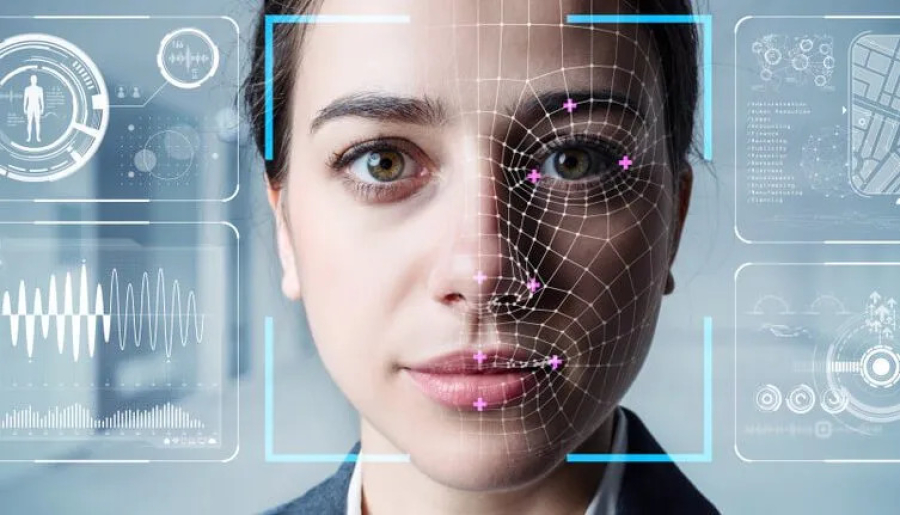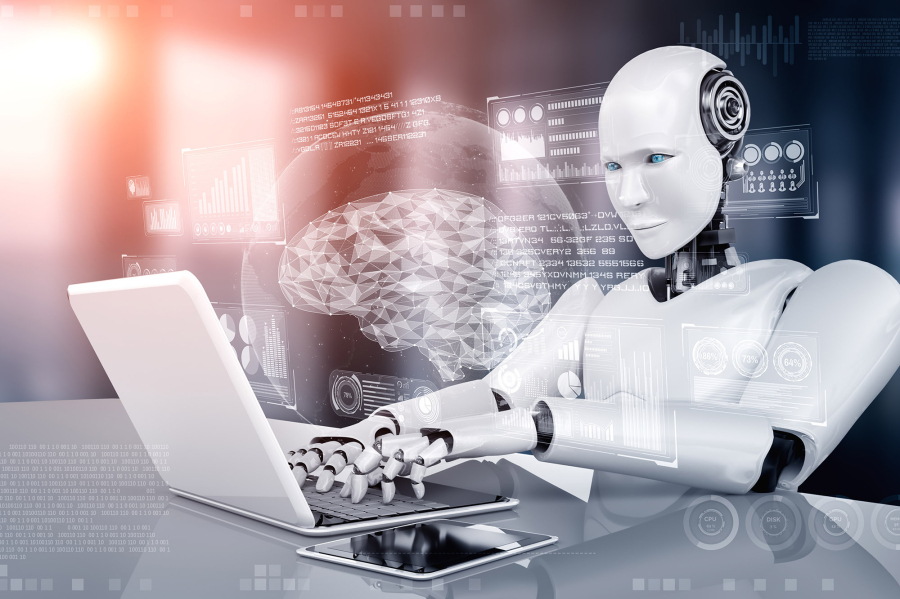AI Marketing Statistics: Data Shows Emerging Technologies Are Here Now
-
Artificial Intelligence Statistics: Artificial Intelligence (AI) that has been once an area of people’s imagination is not a piece of fiction anymore. It has become more common in people’s daily lives. AI is a branch of computer science that focuses on the ability of a machine to replicate the proficiency of the human mind. These days, industries such as tech, telecommunication, financial services, healthcare, and pharmaceutical have become more prominent in adapting AI in organizations. Here are some latest artificial intelligence statistics and trends that will help understand how useful AI is for businesses across the world.
Key Artificial Intelligence Statistics:
- Nearly 37% of trades and organizations utilize artificial intelligence.
- Over 3 billion AI-powered voice assistants are currently in use.
- The number of AI-powered voice assistants will increase to 8 billion by 2023.
- AI is expected to account for $15.7 trillion in the global economy by 2030.
- The global AI market is estimated to reach $267 billion by 2027.
- With 66.000 skills, the highest numbers of Alexa inventory skills are available in the United States.
- AI has the ability to shoot up business productivity by 40%.
- Nine out of the top ten trades have invested in AI technologies.
- The growth of AI is expected to reduce 85 million jobs and create a further 97 million new jobs by 2025.
- The number of AI startups has grown 14 times in the past two decades.
- The AI industry is expected to earn $126 billion per year by 2025.
- 67% of people in the US believe that automatic cars are safer as compared to standard vehicles.
- Investments in AI technologies have grown six times since 2000.
- 25 nations across the globe are currently planning to design autonomous vehicles.
- The wearable AI market size is expected to grow up to $180 billion by 2025.
- Nearly 77% of the devices that are used by people have one or the other forms of AI skills.
- The revenue of the global AI chip market is expected to touch $83.25 billion by 2027.
- Autonomous vehicle industry might be worth over $600 million in the next five years.
- The predicted rate of annual AI growth from 2020 to 2027 is 33.2%.
- As per the data, the Asia-Pacific region will see the highest compound annual AI growth rate by 2025.
- With 26.1% of the global market share, China is expected to emerge as the world leader in AI technologies.
- The lack of trained staff is an expected limitation in the growth of the AI market.
- The US has given a fund of $37 billion to the machine learning application industry in 2019.
- The autonomous industry is expected to reach $667.7 billion by 2026.
AI Usage Statistics And Trends:
#1. Trades and industries with more than 100000 workers are chalking out a strategy to implement AI
As per AI data, three-quarters of executives think that artificial intelligence will help their firms to expand further.
#2. Artificial Intelligence technology is able to boost business productivity by 40%
A study on the effect of AI in 12 developed nations by Accenture has shown that AI technology can double the rates of economic growth by 2035. Artificial intelligence will help people utilize their time efficiently that will shoot up their productivity by 40%.
#3. 41% of users believe that AI will improve their lives in some or the other way
People living in India and China are more likely to include AI technology in their lives.
#4. 47% of recognized firms use a defined AI strategy for mobile
As per the AI statistics 2018, 47% of highly advanced firms have used an AI strategy for their mobile apps while 84% of firms use a personalized AI strategy as a component of their marketing plans.
#5. AI startups have attracted investments of around 36 billion U.S. Dollars. This figure was exceeded in just six months and reached 38.4 billion U.S. Dollars.
#6. Worldwide spending on AI and cognitive systems has reached $57.6 billion in 2021.
#7. Artificial Intelligence will add 12 million additional jobs by 2025.
AI is expected to cut down 85 million jobs and created 97 million additional jobs in the next two years.

#8. Gartner Hype Cycle 2019
- The 2019 cycle included 8 new technologies: AI cloud services and autoML. Augmented intelligence, explainable AI and intelligent devices were all part of the 2019 cycle. Reinforcement learning, quantum computers, and AI marketplaces are also part of the list. Source: Gartner
#9. Gartner Hype Cycle 2020
When it comes to AI stats 2020 there are 2 major trends that dominate Gartner Hype Cycle. They are the democratization and industrialization AI platforms, and Artificial Intelligence. Source: Gartner

#10. Nine out of the top 10 trades have invested in AI technology
However, only 14.6% of them have been using AI abilities in their work.
#11. The number of ventures using AI has shot up by 270% from 2015 to 2019.
#12. 38% of healthcare providers use artificial intelligence as diagnosis assistants.
#13. As per AI statistics, 52% of telephone firms use chatbots now.
#14. Only 33% of consumers believe that they are already utilizing AI platforms
However, the actual number of people using AI is quite higher as 77% of devices that are used by people have one or the other forms of AI skills.
#15. 84% of global trade firms think that AI will help them gain a competitive lead
As per AI statistics 2017, 84% of global trade firms think that using AI will help them have a competitive gain over their rivals in the market.
#16. Artificial Intelligence technology is expected to help boost local economies across the world with China being the world leader in AI technology.
#17. Around one-third of consumers are expected to communicate with AI for commercial engagements.
#18. Considering customer satisfaction, 43% of consumers think that the usage of AI will shoot up customer complaints.
#19. As per AI statistics, 52% of users think that AI will not be able to safeguard their personal data.
#20. A survey says, four out of 10 consumers believe that the usage of AI will prompt companies to become more careful in protecting customers' data.
#21. 49% of consumers think that the usage of AI in the healthcare sector might not be safe.
#22. Nearly 50% of consumers think that their jobs are being cut down by computers.
#23. 28% of people believe that human touch is required to get the job done.
#24. Only 19% of users believe that AI will enhance productivity at their workplace.
#25. As per AI statistics, the Netflix recommendation engine is worth $1 billion per year.
Voice Assistant And AI Statistics:
#26. 40% of people use the voice search function at least once in 24 hours
With this figure, it is evident that the use of voice search is becoming more prominent in people's daily lives.
#27. Towards the end of 2020, 30% of web browsing and voice searches have taken place without a screen
Audio-based tools like Amazon Echo have access to dialogue-based data. As per the latest AI statistics, voice-first interaction will become more prominent in the near future.
#28. AI data 2020 says nearly 7 billion devices already rely on AI-powered voice assistants.
#29. 97% of mobile consumers use AI-powered voice assistants
As per a study done by IDAP, only 2% of iPhone users have never accessed Siri while only 4% of Android users have never used the OK Google feature.
#30. 51% of consumers use voice assistants in their cars.
#31. 1.3% of consumers use AI-powered voice assistants at their workplaces.
#32. 6% of consumers use voice assistants in public places.
#33. 50% of people in the US use digital voice assistants.
#34. A 2017 study shows 46% of people in the US use the digital voice assistant to communicate via their smartphones.
#35. 14% of Americans use AI-powered voice assistants on their PCs or tablets.
#36. Around 8% of US citizens use the feature on standalone devices such as Google Home or Amazon Echo.
#37. There are some AI tools used on CRM platforms as well such as Salesforce and Zoho that offer virtual assistants to their users.
#38. More than 3 billion voice assistants have been in use towards the end of 2019.
#39. 55% of people use speech recognition apps as the voice assistant feature helps them control their devices hands-free.
#40. With an accuracy record of up to 98%, Google Assistant is touted to be the smartest voice assistant.
#41. In the commerce category, Apple's Siri is the least accurate virtual assistant with a 68% of accuracy record.
#42. As per AI statistics, Amazon Alexa is 93% accurate in offering general information.
#43. Amazon Alexa can be accessed on more than 60000 devices.
#44. As of 2021, Alexa offers 80000 skills in the US and more than 100000 skills across the globe.
#45. The smart speaker market has been worth $11.9 billion in 2019.
#46. Nearly 53 million Amazon Echo devices are being used in households in the US.
#47. Amazon has 30% of shares of the smart speaker market.
#48. Google has 17% of shares of the global smart speaker market.
#49. Google has dispatched nearly 95 million of its Google Home speakers in 2019.
Machine Learning And AI Statistics:
#50. As of 2017, Netflix has saved $1 billion by the usage of machine learning
As per a study conducted by Netflix itself, users give up on a search after 90 seconds, considering the fact; the company has come up with a functional machine-learning algorithm that automatically suggests personalized TV shows and movies to its users.
#51. 36% of executives say that they have been using AI to optimize internal business processes.
#52. Nearly 20% of C-Suite use machine learning.
#53. Machine-learning program developed by Google has 89% accuracy.
AI Data On Autonomous Vehicles:
#54. Global revenue of the autonomous vehicle market is touching $173 billion with a yearly growth rate of 36%.
#55. 67% of people in the United States feel those autonomous vehicles are safer as compared to human-driven vehicles.
#56. 35% of people in the US do not feel safe sitting in an autonomous car.
#57. 87% of the people in the US prefer an autonomous car with a human driver who can take up the wheel whenever it is required.
#58. As per the statistics, 30% of drivers feel cruise control has made driving safe on the road.
#59. Volkswagen has spent around $2.6 billion on autonomous vehicle software developer Argo AI.
The Effects of AI on the Job Market:
#60. Intelligent robots might replace 30% of the human workforce worldwide by 2030
Experts believe that the growth of automation will be a contributing factor in joblessness in the future. The human workforce will be reduced by one-fourth of what it has been seen in 2017.
#61. Nearly 375 million people might have to change their professions by 2030
As per AI technology data, robotics might reduce 30% of occupations and replace 800 million employments by 2030. It will lead to nearly 400 million people changing their jobs.
#62. The existing educational format is not prepared for the impact of AI on jobs in 2030 and further on
AI facts show that educational institutions have not prepared today's generation to deal with the effects of automation in the future.
The Prominence of AI Across Businesses:
#63. Experts have estimated that nearly 250 million cars will be equipped with an internet connection towards the end of 2020.
#64. As per AI data in 2020, 29% of AI automation is used for machine and asset maintenance.
Around 30% of AI adoption is used for maintenance. The tool senses when the machine is about to break down and suggests an apt time for repair.
#65. AI adoption in consumer-packaged goods has resulted in a 20% decline in forecast errors.
#66. 70% of manufacturers have still not implemented AI in their businesses
Nearly 30% of firms with AI automation say that it has helped them in terms of relationships with customers and suppliers.
#67. AI adoption might reduce 30% of nursing activities by 2030
However, AI data in the healthcare sector shows that humans will still perform 90% of nursing activities by 2030. On the other hand, the WHO has declared that the healthcare sector will see a shortfall of around 18.2 million healthcare workers during the same time. If it turns out to be true AI will be the only option left.
AI Statistics in Retail Business
#68. As of 2021, 73% of retailers have planned to implement AI to determine their pricing.
#69. 75% of firms have decided to use AI systems to reduce frauds
AI data shows those smart algorithms are efficient in reducing credit card fraud.
#70. The compound annual growth rate (CAGR) of AI technology is expected to touch $15.9 billion by 2025
AI technology is expected to grow at a CAGR of 35.9% by 2025.
#71. Amazon has decreased its 'click to ship' time to 15 minutes with machine-learning that accounts for a 225% reduction.
#72. As per a survey, 87% of AI consumers have said that have used AI technology for sales forecasts and enhancing their email marketing.
Artificial Intelligence Marketing Statistics:
#73. The Fourth Industrial Revolution will be valued at $7 trillion by 2025
AI technology will be valued at $4 trillion by 2025.
#74. The global AI market is expected to grow to $22.6 billion
As per the AI statistics, the growth of artificial intelligence drivers such as Natural Language Processing (NLP) machine learning, and computer vision will reach $23 billion in the fourth quarter of 2020.
#75. AI will account for 26% of China's GDP (Gross Domestic Product) by 2030
AI will contribute to 14.5% of North America's GDP and 13.5% of the United Arab Emirates' GDP as well.
#76. The Global AI market is expected to grow by $120 billion in 2025.
Chatbots And AI Facts:
#77. In the near future, 85% of customer's relationships with business ventures will be tackled without human engagement
#78. 67% of people prefer messaging apps to talk to a business; it shows chatbots are quite significant these days.
#79. 38% of people worldwide prefer using chatbots
As per a survey of 5000 people across six nations, 38% of people have rated their overall experience with chatbots as positive. Around 51% of them have rated their experience with chatbots as neutral and 11% of them have rated it as negative.
Statistics On AI Growth:
#80. AI-based startups have grown 14 times since 2000
While investments in AI-based startups have shot up six times.
#81. AI is expected to automate 16% of jobs in the United States by 2025.
#82. As per the data, machine learning is expected to grow further by 48% in the automotive industry
Both semi and fully autonomous vehicles will solely depend on AI systems.#83. 15% of business firms use AI technology and 31% of these firms are planning to use it for the next 12 months.
#84. Customer Insight-driven traded will earn more than $1.2 trillion per year as compared to less aware rivals in the future
As per AI statistics, businesses that are more customer-centric will be more successful in terms of revenue and profits.
#85. The future of artificial intelligence appears to be bright in financial services as well
As per AI statistics, financial service firms are planning to spend $11 billion on AI technology in 2020.
#86. 72% of executives believe that artificial intelligence will turn out to be the most profitable business benefit of the future.
Artificial Intelligence Adoption Data:
#87. Informatica has included an AI-inspired addition on its platform
The AI addition introduced by Informatica is known as Claire. It is supposed to make finding, visualizing, and using data quite easily.
#88. An IT firm known as Accenture has unveiled its testing services for artificial intelligence systems
These services are powered by the 'Teach and Test' method to help firms track and measure artificial intelligence products in their in-house systems.
#89. Nearly 27% of executives say that their firms have plans to invest in AI cybersecurity safeguards
Experts say that using AI systems in organizations will prevent cyber attacks. They say that looking at the rising number of cyber attacks and security breaches; it is advisable to use AI systems in companies. A couple of firms are already designing AI-powered cloud-based threat lakes.
#90. AI statistics for 2019 show that 40% of digital transformation and 100% of schemes based on the internet will be powered by artificial intelligence in the near future.
Conclusion:
These AI statistics mentioned above prove that artificial trend is not a passing trend in business. A large number of small and big business firms are trying to reposition their strategies to incorporate more AI-enabled technology. Artificial intelligence is growing in two diverse directions one is autonomous machines and another is machine learning. Experts say that machine learning is going to be more prominent in the future. Along with this, new jobs are being created in this field to accommodate the growing AI market across the world.











Comments (5559)
Diplomi_kzkr
19, Dec 2025купить диплом с медицинским образованием купить диплом с медицинским образованием .
Diplomi_blmi
19, Dec 2025диплом техникума спб купить https://r-diploma12.ru .
Diplomi_aakl
19, Dec 2025диплом вуза купить спб www.r-diploma13.ru/ .
OscarDot
19, Dec 2025Let me share the harsh truth: most septic companies just pump tanks. They are like quick-fix salesmen at a demolition convention. But Septic Solutions? They're different. It all originated back in the early 2000s when Art and his family—just kids scarcely tall enough to carry a shovel—assisted install their family's septic system alongside a experienced pro. Imagine this: three youngsters buried in Pennsylvania clay, learning how soil permeability affects drainage while their buddies played Xbox. "We never just dig holes," Art shared with me last winter, hot coffee cup in hand. "We discovered how earth whispers mysteries. A patch of wetland vegetation here? That's Mother Nature screaming 'high water table.'"
https://500px.com/p/actachtfxj
Diplomi_zxkt
19, Dec 2025как купить школьный аттестат как купить школьный аттестат .
Diplomi_pxen
18, Dec 2025купить аттестат образование купить аттестат образование .
Diplomi_bypn
18, Dec 2025диплом купить в благовещенске диплом купить в благовещенске .
Diplomi_iosa
18, Dec 2025купить диплом в люберцах купить диплом в люберцах .
private_tcea
18, Dec 2025Discover a world of luxury and comfort with private jet hire london!
Alongside comfort and privacy, the amenities available on private jets elevate your journey to new heights.
privatjet_ycon
18, Dec 2025privatjet mieten
bietet eine breite Palette von Dienstleistungen fur diejenigen, die mochten private jet mieten.
Ob geschaftlich oder privat, die Vorteile sind zahlreich.
Diplomi_crkn
18, Dec 2025купить диплом ярославль купить диплом ярославль .
Diplomi_hlpi
18, Dec 2025купить диплом о высшем образовании пермь купить диплом о высшем образовании пермь .
OscarDot
18, Dec 2025Let me share the harsh truth: most septic companies just maintain tanks. They're like temporary salesmen at a chainsaw convention. But Septic Solutions? These guys are special. It all began back in the beginning of the 2000s when Art and his family—just kids barely tall enough to shoulder a shovel—helped install their family's septic system alongside a weathered pro. Imagine this: three youngsters buried in Pennsylvania clay, learning how soil absorption affects drainage while their peers played Xbox. "We didn't just dig trenches," Art shared with me last winter, hot coffee cup in hand. "We discovered how ground whispers mysteries. A patch of wetland vegetation here? That's Mother Nature yelling 'high water table.'"
https://raindrop.io/odwaceaanf/bookmarks-64277096
gotovye_xeea
18, Dec 2025Профессионалы могут помочь с подготовкой участка и планированием необходимых этапов.
купить готовый проект дома https://gotovye-proekty-domov9.ru/
fixTurse
18, Dec 2025Не пропустите актуальные события и аналитику.
Особенно понравился материал про Актуальные новости и аналитика в мире спорта.
Ссылка ниже:
https://moskvacska.ru/
Завершаем на сегодня, но спортивный мир не стоит на месте.
Diplomi_tder
18, Dec 2025купить диплом вуза куплю диплом о высшем образовании купить диплом вуза куплю диплом о высшем образовании .
Diplomi_chkr
18, Dec 2025купить диплом о высшем образовании в санкт петербурге отзывы купить диплом о высшем образовании в санкт петербурге отзывы .
Diplomi_dmkr
18, Dec 2025купить диплом по дизайну купить диплом по дизайну .
Diplomi_gmmi
18, Dec 2025диплом о высшем образовании купить недорого диплом о высшем образовании купить недорого .
OscarDot
18, Dec 2025Here's the harsh truth: most septic companies just maintain tanks. They're like temporary salesmen at a demolition convention. But Septic Solutions? They are different. It all originated back in the early 2000s when Art and his siblings—just kids hardly tall enough to lift a shovel—aided install their family's septic system alongside a grizzled pro. Picture this: three kids buried in Pennsylvania clay, learning how soil absorption affects drainage while their buddies played Xbox. "We did not just dig trenches," Art told me last winter, warm coffee cup in hand. "We understood how soil whispers mysteries. A patch of cattails here? That's Mother Nature screaming 'high water table.'"
https://www.mapleprimes.com/users/belisacdcy